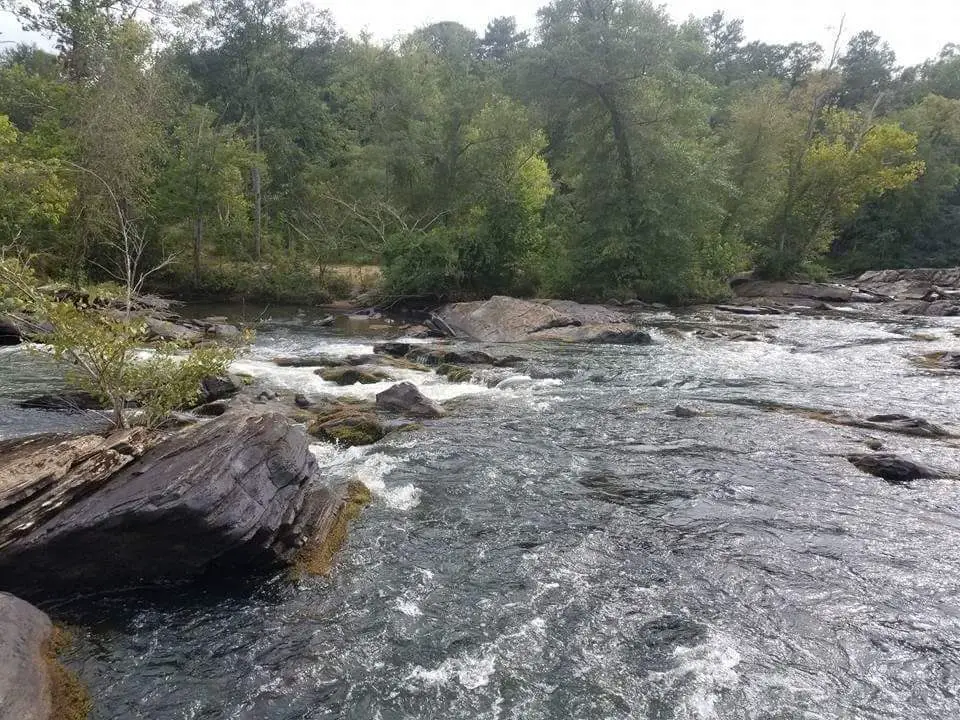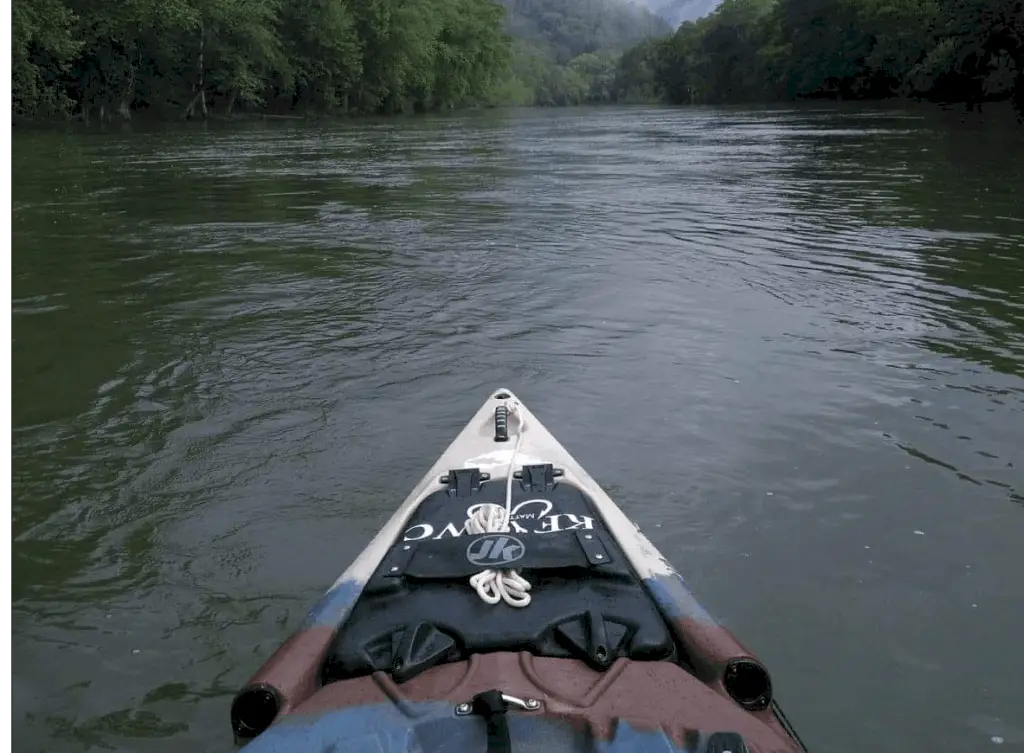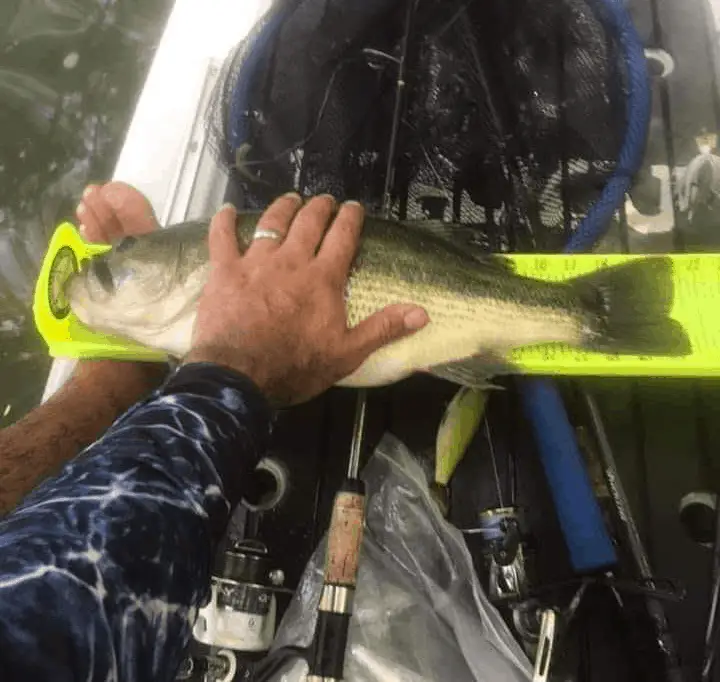First-timers and experts alike, we all want to brush up on our knowledge of fishing and catch more fish. Before I took to kayak fishing in a river, I learned as much as I possibly could. Now with several years of kayak fishing under my belt, I have learned some nice tricks to bring in the bass no matter the weather, time, or river location. If there are fish to be caught, specifically smallmouth bass, we will find them.
These are my best tips to double your catch rate on any river.
1. Head to the Eddies
River eddies are considered hazards to most people, and they very well are. To us, an eddy is a prime fishing location.
The eddy is caused by a large obstruction in the flow of the river, usually, a rock, which has a visible ‘boundary’ called an eddy line. Inside of the eddy, the current is the opposite of the water around it. Eddies can also form in a bend of a river or alongside along shores away from the main flow of the river.
Most fishing kayaks are short enough to sit in an eddy, which will stop you from being pushed downstream. Doing this will give you an up-close and personal fishing experience right where the big fish hang out, in fast-moving water.
The eddy is effective because weaker fish and other food normally end up in these swirling pools, making it the perfect feeding ground for a bass that is strong enough to get there.
The approach is the most important part. Eddies tend to be shallow and have clearer water. The best way to fish an eddy is to cast into it while sitting in an adjacent one.
As far as bait goes, try using something subtle and lightweight so it matches the prey around it.

2. Learning How to Anchor Your Kayak in a River
Learning how to expertly utilize an anchor during your river trips will increase the amount of fish you catch. Being able to spot a good looking fishing hole is one thing, but being able to drop an anchor in a river to fish it is invaluable.
Dropping an anchor and fishing is simple, the safety of how to rig it and when to deploy it is what is important here.
With that being said, There is a very fine line between using your anchor correctly and flipping your kayak, so make sure you know how to properly set your anchor and what to look for before doing so. Do not attempt to anchor your kayak in swift-moving water or if you are not one-hundred percent confident in your abilities. This practice is frowned upon in the kayak fishing community for safety reasons.
I use a 3-pound barbell as an anchor. Whatever you choose you will want to make sure it won’t snag on rocks so it will be easy to retrieve, so avoid claw style anchors.
Do not use an anchor that grabs like a claw or anything that weighs over 3 pounds. If a 3-pound anchor can’t hold you in place, then you’re trying to anchor somewhere that is moving too fast.
Since anchoring in a river can be very dangerous, it is very important that you are able to break your anchor line at a moments notice. Do not ever use a standard cleat on your anchor line when you intend on using it in a river. Instead, opt for a clam cleat so that you can free your line without introducing a knife to an already volatile situation. Another option is to rig your anchor line with a carabiner so you can release your anchor with a flick of the thumb.
If your river of choice is shallow enough, a stakeout pole is also a viable option.
You can read more about anchor options here: Why a Kayak Anchor is a Must-Have (With Examples)
3. Maneuvering A Kayak With More Than A Paddle
When it comes to flowing down a river with the current, you will most likely only use your paddle to maintain course and avoid obstacles instead of propelling yourself forward. In the same way that your paddle affects your kayak’s movement, your bodyweight can as well.
Learning to twist your hips or apply pressure to the footpegs of your kayak to steer is a useful and underrated trick. You will need to use both hands to fight a fish on your line and reel at the same time.
Start by practicing in flat water by paddling to gain speed and then shifting your weight from one side to the other to see how that affects your kayak. Every style and brand of kayak will perform differently, so it’s important that you get out and practice with your kayak.
This would also be a good time to point out that you should practice paddling with one hand while holding your pole in the other. The best way I have found to accomplish this is to sit your paddle in the bend of your elbow, run your forearm down the pole of the paddle, and grip it.
Fighting an upstream battle while continuously moving downstream is not an effective way to reel in your catch and you run the risk of letting the fish find ways to snap your line. Paddling upstream in slower moving areas while fighting with your pole in the other hand is a tricky technique to master, but infinitely useful when you need it.
4. Learn to Read the Water

While reading the current may seem a bit obvious for a kayaker, you want to learn how to read the water as a whole and understand how that affects the movement of the fish. Surprisingly, reading the water is much more simple than many anglers believe.
Be sure to watch your approach; Be wary of getting too close to potential fishing locations on the water as you will most likely scare the bigger catches away. Sit back and scan the area with your eyes a minute or two before moving it. You will be very surprised by how much you missed before.
There are three key factors that you’re looking for while reading the water: cover, food, and borders.
- Cover – This is anything that provides a hiding place for predator fish to ambush smaller species. Examples of cover are vegetation, large rocks, weed beds, logs, or brush that is hanging over the water from the bank of the river.
- Food – Fish have to eat and they have a pretty broad diet too. What you’re looking for here are smaller schools of fish, insects on the top of the water, or brush hanging over water that has a lot of spider webs in it.
- Borders – Predator species love to hang out on the many borders of the water. When I say borders I’m specifically talking about places where the water makes a transition. From shallow water to deep, from covered water to open, or from swift-moving currents to a slow-moving spot is what you’re looking for. In a river especially, fish will always hide in the borders of slow and swift-moving water; this makes it easier to hunt weaker prey that is brought to the predator by the current.
In a river setting, smallmouth bass and all other fish must expend energy in order to fight the current. Learning how to read the water and locate the fish will keep you from wasting time by casting straight into the rough of the river. Just like finding smaller eddies in the river, look for breaks in the flow. Here is an example of reading the water:
Any large object in the water creates an obstruction of flow and that’s where your fish will find its cover.
It’s safe to assume weaker prey fish are being pulled down the river by the current, so food is traveling right by the cover.
And lastly, in this situation, the cover also provides a break from the current; which creates the border the fish is looking for too.
5. Drifting Techniques
The current is what makes river fishing so efficient. If you’re not letting the current pull you down the river, you’re fishing the river wrong. In most cases, anglers will paddle against the current and ride back down or ride the current from point A to point B, which is what you want to do. What you don’t want to do is fight the current and the position it puts your kayak in constantly.
The more time spent fighting to get the perfect position with your kayak is less time spent fishing, and that’s not good at all. The only time you should really adjust your trajectory is if you’re heading towards an obstacle, an undesired direction, or into danger.
Keep in mind that your kayak will never face directly downwind but will instead slightly face right or left. You can change your position in the water with a quick dip of the paddle from port facing (left) to starboard facing (right) or back again. Finding out which orientation works best for you is what matters most here.
6. Fishing Upwind
Much like paddling against the current, attempting to fish upwind is extremely inefficient. Paddling and casting are affected by wind and more than you might think for the former. Depending on your chosen kayak (style and build wise), you may find yourself being bullied by the wind more than other kayak anglers.
There a few tips I can provide to help assist any angler in windy conditions.
- Seek vegetation – Seeking out clumped up vegetation and paddling into it will give your kayak something to hold onto other than the water’s surface. While paddling into thicker vegetation won’t stop the wind from pushing you, it can slow you down when the wind isn’t very strong. Once you reach your desired fishing location, you can cast downwind for a little boost in range.
- Drop an anchor – As I covered before, dropping an anchor in a river can be tricky business. If you have mastered the art of safely dropping your anchor, then it can provide you some relief from the wind and take the hassle of the current out of the equation. The downside here is that if the wind isn’t blowing downstream you may find yourself moving side to side if the wind is gusting hard enough.
7. Using The Weight of Your Kayak to Fight Fish
I was surprised to learn how effective a kayak works as a second drag system for fishing. This tip is more for largemouth bass or larger fish species but can be applied to almost all fish, especially large smallmouth. A strong four-pound fish can tow your kayak.
The cool thing about having the fish fight the weight of your kayak means that you can afford to make small mistakes with little to no consequence. Your drag can be too tight or your reaction time be too slow and that fish will still have a hard time breaking your line.
Smallmouth love to fight and can be really strong so if you find yourself hooking a fish you aren’t quite prepared for, no worries. A 6-pound test line will hold its own against the toughest and largest of smallmouth for a short period of time.

8. Packing Light/ Gear Selection
Fishing is a game of gear, and we all know that. Just like me, I bet that you have at least a couple of bags of plastic bait you bought several months ago you have yet to use. Kayaks have limited space which causes you to be very deliberate with your bait selection; which isn’t necessarily a bad thing.
Be confident in your bait selection and go with it. The limited amount of space provided by the fishing kayak will not only force you to pack light and bring fewer lures but save you time by eliminating your options which keeps you from digging in your bag instead of fishing.
9. Lure Choice & Rigging
You can greatly increase your catch rate by simply using the right bait. Strolling down the aisle of the bait shop can be intimidating and to be honest I’m still not sure what roughly one-third of it does. I just know what works for me and I’m always looking to learn new ways to fish. However, sticking to what I know allows me to consistently catch fish.
Craw-jigs, tubes, stick worms, and jerk bait are my favorite basic plastics because they mimic common natural prey found in rivers. I like to fish with square bills, spinnerbaits, and some top-water lures as well.
Pole Set-up
A seasoned kayak angler will carry several fishing poles on their kayak. Each pole is rigged for a different lure or style of fishing, this saves time and hassle.
Like I mentioned before, 6 to 8-pound monofilament line should be good enough to catch any smallmouth, barring a supernatural river monster.
You can take a look at all the gear I use on my Recommended Gear page

10. Be Safe
Safety should be your number one priority in all that you do, and kayak fishing is no exception.
The river is especially dangerous depending on how fast the water moves and what kind of rapids lay ahead of you. Here are some tips to stay safe while kayak fishing in a river.
- Always wear your PFD (Personal Flotation Device)! There are kayak fishing specific PFDs all over the market that are small, breathable, and hold fishing gear. There is no excuse not to wear one.
- Plan your float trip before you go. Take note of any rapids or hazards along your float.
- Use the buddy system. While not mandatory, taking a friend with you not only makes the trip more fun but also provides an extra set of hands if something goes wrong. At Least let someone know where you are going.
- Wear sunscreen and bug spray.
- Wear protective clothing.
- Bring a first aid kit, some drinking water, and at least one meal. Even if you don’t plan on eating during your trip you never know what may happen. I would always rather have something I don’t need than need something I don’t have.
The dangers of kayak fishing are more abundant than you may think you can read more on that here: “Kayak Fishing Is More Dangerous Than You Think, Here’s Why”
11. Get Out There
You can read hours of content and watch even more YouTube but the fact is you won’t actually catch anything unless you get out on the water and fish. We can only learn so much through the internet before we have to get out there and try out what we have learned and see what works best.
My biggest piece of advice when it comes to kayak fishing in a river is to get out on the river and fish. You’ll be surprised how much you can learn by just getting out there and watching the people and nature around you. Don’t be afraid to approach other kayak anglers and ask for advice, they are almost always willing to help.
Remember that a bad day fishing is still a good day kayaking.

